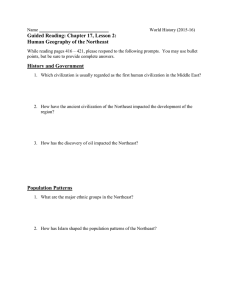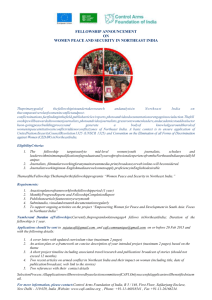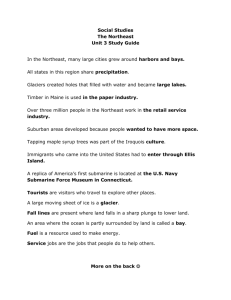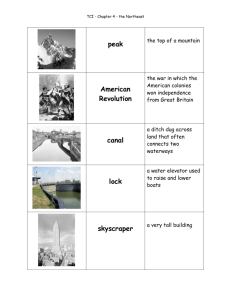Source
advertisement
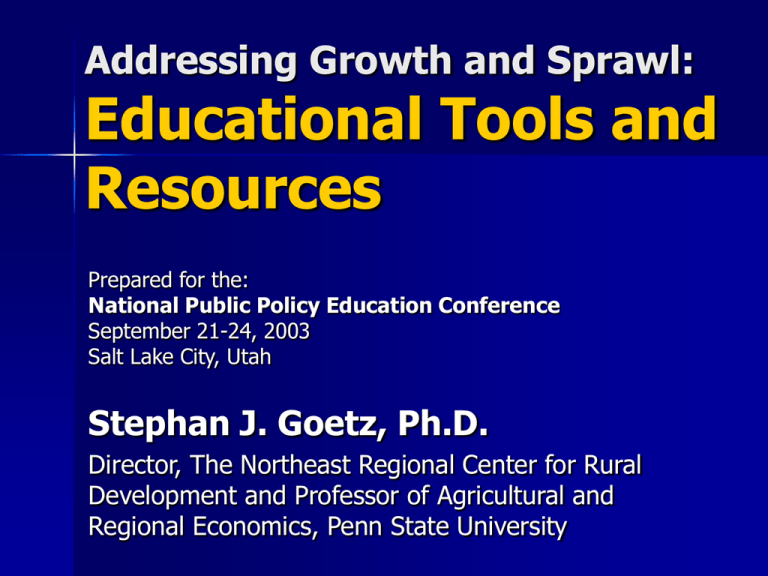
Addressing Growth and Sprawl: Educational Tools and Resources Prepared for the: National Public Policy Education Conference September 21-24, 2003 Salt Lake City, Utah Stephan J. Goetz, Ph.D. Director, The Northeast Regional Center for Rural Development and Professor of Agricultural and Regional Economics, Penn State University Presentation based on: “Ten Things Members of Every Community (in the Northeast US) Need to Know About Land Use…” Edited by Stephan J. Goetz and Tim Kelsey, June 2003 Available on The Northeast Center’s website www.cas.nercrd.psu.edu 1. No other region of the country faces greater pressure on its land base than the Northeast US. (The Northeast Center) The region has 22% of the population, but only 6.7% of the nation’s land area. Choose a comparable fact for your region (e.g., availability of water in the West). Measures of Urbanization, 1982-97, by US Region (adapted from Fulton et al. 2001) Northeast Midwest South West 0 Urban land change 20 40 Population change 60 Ratio 2. Once traffic gridlock occurs in a community, it is almost always too late to do anything about it. (Brookings) And, traffic gridlock is growing across the nation Most cities cannot sprawl their way out of congestion The following examples are for cities in the Northeast, but congestion cost patterns are similar elsewhere in the US Mobility Data for Baltimore, MD, 1982-2000 4000 450 Density 400 3500 350 Population Density 300 2500 250 2000 200 1500 150 1000 100 Congestion Cost 500 50 0 0 1982 1983 1984 1985 1986 1987 1988 1989 1990 1991 1992 1993 1994 1995 1996 1997 1998 1999 2000 Congestion cost per capita 3000 Mobility Data for Boston, MA, 1982-2000 3000 600 Density 500 Population Density 2500 400 2000 300 1500 200 1000 Congestion Cost 100 500 0 0 1982 1983 1984 1985 1986 1987 1988 1989 1990 1991 1992 1993 1994 1995 1996 1997 1998 1999 2000 Congestion Cost per Capita 3500 1720 Mobility Data for Hartford-Middletown, CT 1982-2000 250 1700 Population Density 1660 Density 150 1640 1620 100 1600 1580 Congestion Cost 50 1560 1540 0 1982 1983 1984 1985 1986 1987 1988 1989 1990 1991 1992 1993 1994 1995 1996 1997 1998 1999 2000 Congestion Cost per Capita 200 1680 3750 Mobility Data for Washington DC-MD-VA, 1982-2000 700 3700 600 3600 Population Density Density 500 3550 400 3500 3450 300 3400 200 3350 Congestion Cost 3300 100 3250 3200 0 1982 1983 1984 1985 1986 1987 1988 1989 1990 1991 1992 1993 1994 1995 1996 1997 1998 1999 2000 Congestion Cost per Capita 3650 3. Planning is usually the only way in which unpleasant surprises related to land use can be avoided. (M. Dougherty) Planning: an orderly, open approach to determining local needs and wants, describing a vision of community’s desired future, setting goals, priorities, and taking action. Zoning, capital improvements, and subdivision ordinances guide land use decisions. Source: T. Wilson and G. Blonde, Lay of the Land Land Use Education Program, 2002, U. of Wisconsin Planning is not… an attempt to replace market forces or stop growth altogether – a magic bullet, or a tool of immediate change – It is to manage future community development It is a tool to foster long-term impacts static or only done once the same as zoning Source: T. Wilson and G. Blonde, Lay of the Land Land Use Education Program, 2002, U. of Wisconsin Questions behind planning… Is there something in your community that you want to: change? preserve? create? Source: T. Wilson and G. Blonde, Lay of the Land Land Use Education Program, 2002, U. of Wisconsin The Northeast Regional Center for Rural Development A good plan can… Control taxes and preserve or protect: farmland, private property rights, the environment, etc. Guide and promote development Lead to consistent decision making over time Most importantly: achieve your desired “vision” – what you want for the future Source: T. Wilson and G. Blonde, Lay of the Land Land Use Education Program, 2002, U. of Wisconsin Planning involves four basic questions for the community… 1. 2. 3. 4. Where is it now? How did it get there? Where does it want to be? How does it get there? Source: T. Wilson and G. Blonde, Lay of the Land Land Use Education Program, 2002, U. of Wisconsin Question: Are communities that plan more highly “developed”? 4. The smaller the unit of local government, the greater the potential local control of land use and planning... (Stanley Lemback) But, the fewer the resources available for planning, and the greater the staffing problems Under home rule, there are thousands of units of local government (townships, municipalities, etc.) Local officials often serve on part-time, volunteer basis; turnover is high Thus, dealing with complex land use trade-offs can be a serious challenge in areas with home rule 5. Generally speaking, the nation’s food supply is at this time not threatened by land conversion to new housing development. (Heimlich and Anderson) Exceptions… 6. Compared to previous economic expansions, and given the amount of population growth during the last decade, developers are currently undersupplying new stocks of housing. (The Northeast Center) Population growth (mn.) New housing units (mn.) New Homes (per 100 popl.) 1970s 1980s 1990s 23.2 22.7 32.7 17.5 14.8 13.3 75 65 41 But these homes are being build on larger lots Housing affordability is a growing concern, especially in the Northeast Housing affordability is a key measure of economic well-being Gentrification is believed to be a growing problem As population density rises, housing affordability tends to decline Or, in areas with lower density, housing affordability is higher 7. There is no clear-cut relationship between land preservation efforts and the supply of housing. (Brookings) We also know little about the long-term effectiveness of farmland preservation programs. (L. Lynch) 8. Conventional cost of community services studies need to be used with caution – and they are often misused. (T. Kelsey) Median COCS per dollar of revenue raised Commercial/Industrial Farm/Forest Residential Source: J. Freedgood, 2002 (AFT) $0.27 $0.36 $1.15 9. Some individuals claim that residential development is always beneficial to a community because of the increased tax dollars it brings; others claim costs of residential development are always negative because new school expenses offset any potential tax benefits. Neither assertion (stereotype) is in fact accurate. (T. Kelsey) 10. Property rights are granted to individuals by the community in which they reside. (D. Bromley) Additional resources The Future of Agriculture in Your Community (T. Kelsey, T. Collins, K. Brasier) GIS and Your Community (O. Tunceli, T. Collins, S. Goetz) Extension Land Use Programming Workshop Proceedings, May 2003 (S. Goetz and T. Kelsey) Land Use/Land Cover Mapping Capability Land Use Web Resources (T. Collins, P. Marshall)


